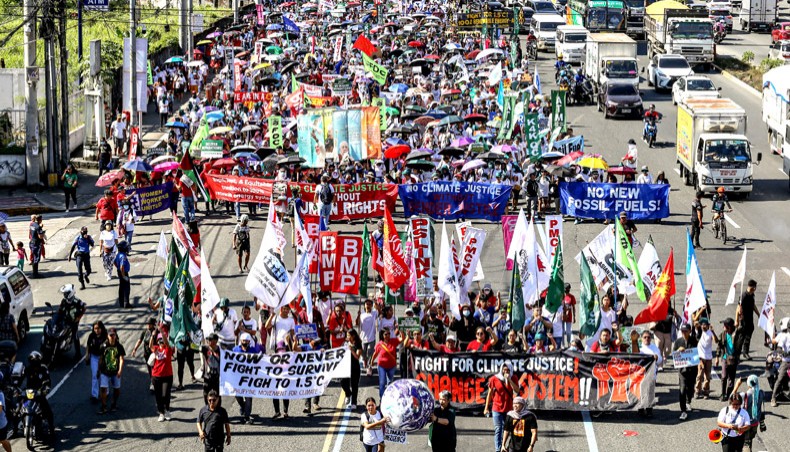by Mohammad Azaz | Published: 00:00, Dec 10,2023

Protesters take part in the Global Day of Action for Climate Justice along Commonwealth Avenue in Quezon City on December 9 to demand urgent climate action at COP28 United Nations climate summit in Dubai. — Agence France-Presse/Earvin Perias
WHEN we are discussing the 1.5°C threshold, the global target has already been heading towards the 2°C threshold. The question is, where did this come from? What was the original baseline? Right now, many people at the COP28 conference are talking about 1.5°C. The Godard Institute of Space Science data shows that we were going to reach about 1.5°C this year. What baseline is that, relative to the 1850–1900 baseline, which is the baseline that basically everybody uses now? We can call that baseline two because those 1.5°C and 2°C numbers were first thrown about at the Paris conference and in IPCC reports. Before then, at least a two-degree number of the baseline was pre-industrial. Pre-industrial was usually the date that was not given, but it was 1750. The problem is that there is a baseline shift because the temperature in 1750 was lower than the average temperature between 1850 and 1900. The Industrial Revolution started in the mid-1700s, when they started burning coal. We did not have many good ways to measure temperature at the time. Baseline one being 1750 and baseline two being 1850 to 1900, that shift is, if we look at the temperature curves, 0.2 to. 3°C. Many of us have argued for 0.2°C. The current augments for 1.5°C have not resolved. The World Meteorological Organisation just put out a new report that shows the temperature is at 1.4°C plus or minus 0.12°C. If we add the 0.12°C, we will get 1.52°C. So, it is close to being within air bounds.
Let us focus on this 1.5°C threshold. If we asked our leaders, what they mean by the 1.5°C threshold, the will say 1.5°C when the temperature is above the pre-industrial level, and they will say that it is 1850 to 1900. The reality is that the temperature had already reached 1.5°C for a day or two, and we actually passed 2.0 °C for a few days just recently. Is that threshold not gone? Some of our present leaders might say, maybe we need an average of 1.5°C above the pre-industrial level for a month, for half a year, for a year, or maybe for 10 years, or let us make it 30 years. Now the baseline three is from 1990 to 2000, and we can talk about the 1.5°C threshold for another bunch of years. Because the number itself is meaningless without a baseline. Can we create a baseline three? Maybe that will be done by this COP.
The BBC just came out with a recent article on the climate crisis and the 1.5°C threshold, and it turns out that they argue some interesting things. As part of the nation’s climate pledge from the climate clock in New York’s Union Square, in any conversation about climate change, figure 1.5°C is rarely far from the discussion as figure 2.0°C. But when people talk about 1.5°C, most people cannot answer this question. It is the wrong metric we are looking at. If we overshoot, it will be able to come back below 1.5°C again.
The 1.5°C stretch target in the Paris Agreement came as something of a surprise. The damage done at the 1.5°C threshold depends on how we get there if we overshoot it and then reduce back, the risk is greater than if we just stabilise at 1.5°C. The peak temperature is also very important. But have we not passed the 1.5°C threshold already? 2023 is on track to be the hottest on record; in July and September, the global average daily temperature was more than 1.5 °C higher than the pre-industrial age average. Roughly one-third of the days in 2023 are said to have hit 1.7°C in the last few months, which brings up the average.
What would policymakers talk about? We are past the 1.5°C threshold. Next is the 2°C threshold, unless we change the baseline.
Is the 1.5°C threshold the right target? Some argue that it is not the final target. Because of the extreme weather damage that we are seeing today, the 1.5°C is too high. We need to get back down to 1°C so that we can always shift the baseline up. But the climate does not care about baselines. It is an artificial thing.
We keep shifting it and not telling people that even at 1.5°C, the risk to crops could lead to a global food crisis and push us past crucial climate tipping points. This is where we are heading. We are heading towards a global food crisis. Can we exploit new sources of fossil fuels and still meet the 1.5°C target while burning fossil fuels causes more than 75 per cent of human greenhouse gas emissions and more than 90 per cent of carbon dioxide emissions from human activities? Fossil fuels produced are more than enough to breach the 1.5°C threshold. There is a report by the International Institute for Sustainable Development; we are looking at 3°C by the end of the century. Bill Gates said there is no chance of a 1.5°C rise, and innovation and climate technology like carbon capture could help us a lot in 2022. A number of media outlets declared that it was time to say goodbye to 1.5°C.
Leadership from the US and China would help, especially from the COP28 climate summit, which is well underway right now. Biden and XI are not attending, but they had a meeting just before where they talked about methane a bit. They did not talk about climate that much. It was mostly the Middle East, Russia, and Ukraine. But it is critically important for the US and China to come forward with a strategy. They better do it quickly before Trump takes over the US and cancels all the climate work and everything done to address climate change.
The loss and damage funds are talked about. The baseline everybody uses is 1850–1900, which is the key point this year. We are very close to 1.5°C above that baseline. The original baseline is the year 1750, so add 2°, 3°, or 0.14°, depending on which one seems the most plausible. So that does not work in our favour. It means the temperature is higher than we were saying. May be the biggest thing coming out of COP28 is changing the baseline from 1990 to 2000 and then saying — we are good and nowhere near the 1.5°C threshold.
Mohammad Azaz is chairman of the River and Delta Research Centre.
News link: COP28: the 1.5°C threshold (newagebd.net)
